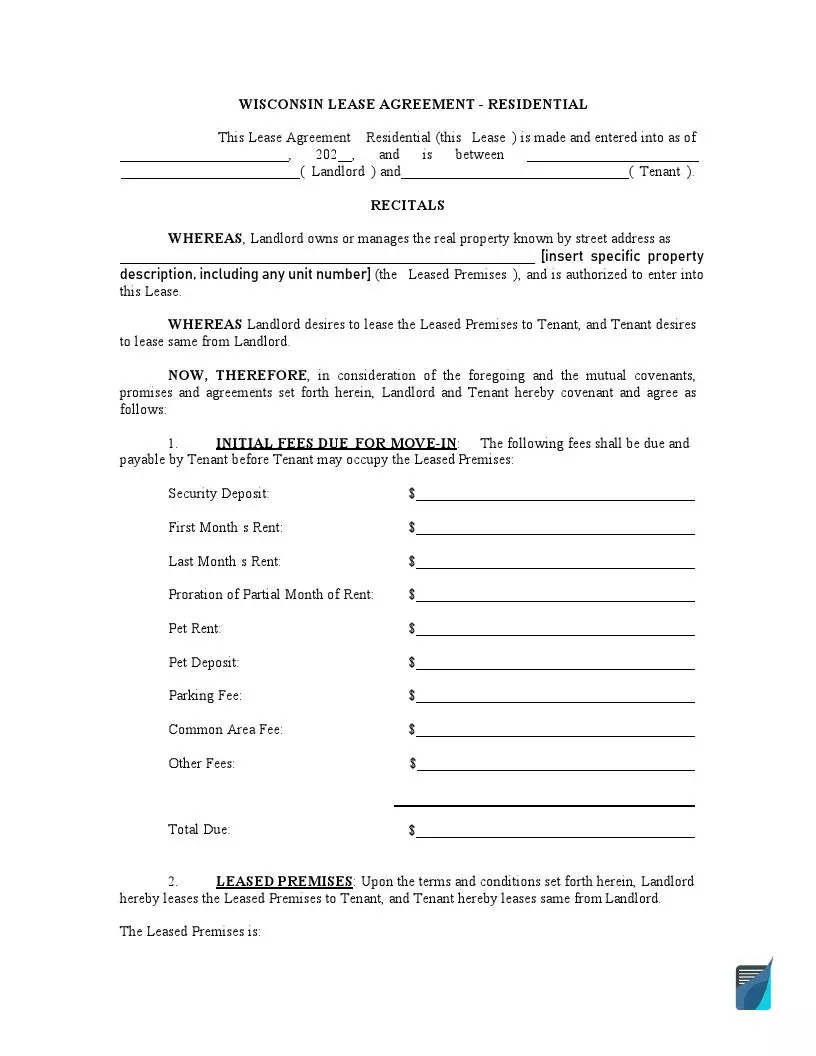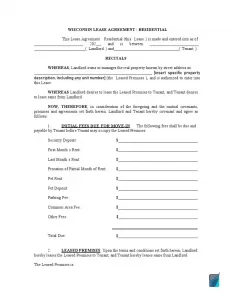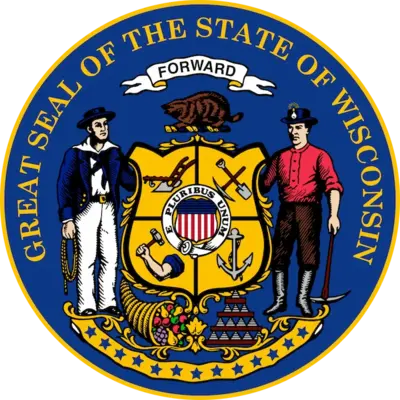Wisconsin Rental Lease Agreement Forms
A rental agreement is a binding contract between two parties. One is the lessor who typically owns the property, and the other is the leaseholder who wants to use the property in exchange for rent. The parties are commonly called the landlord and the tenant, especially in the case of residential property leases. A Wisconsin rental agreement ensures that the rights and responsibilities of the landlord and the tenant are recorded and agreed upon by both of them.
Rental agreements can vary in duration. While most of them apply for a fixed period, typically of a year, there are other options, too. Month-to-month arrangements are typical for periods after the fixed time of the tenancy is over. Rental agreements always contain information about the duration of the lease so that there is no contraversion at the end of the tenancy.
One of the advantages of having a rental agreement is that everything that may become a concern during the rental period will be already discussed in written form in a document. You can have an oral agreement in Wisconsin, but it is uncommon because it is much more difficult to prove specific points in court.
Use our form building software to create your Wisconsin rental agreement quickly and easily.

Build Your Document
Answer a few simple questions to make your document in minutes
Save and Print
Save progress and finish on any device, download and print anytime
Sign and Use
Your valid, lawyer-approved document is ready
Wisconsin Laws and Lease Requirements
Mandatory Disclosures
First of all, the lessor needs to know that the federal laws require them to have a lead-based paint disclosure ready for properties built before 1978. Other mandatory disclosures can vary from state to state, but they are mostly similar. These are the disclosures that the lessor must always include in a rental agreement in Wisconsin:
- The information required for the identification of the lessor. The tenant must be able to contact the landlord or another person responsible for the property without issues. Moreover, the address of this person should be in the state of Wisconsin. If it changes, the landlord must notify the tenant within ten days.
- Building or housing code violations. First of all, the landlord should keep up with the housing codes in their area. If there is any potential danger that can arise from the housing unit’s conditions, or if there are any known violations of the housing code, the landlord must let the tenant know.
- Operating conditions of the property. These mostly concern the state of electrical wiring and other building conditions that may be relevant to the tenant.
- Utility charges. Sometimes these are included in the rent. Sometimes the tenant has to pay for the utilities. In any case, this is something that should be discussed between the landlord and the tenant. The landlord also must let the tenant know if these are not included in the rent.
- The amount of the deposit and other essentials, such as rent amount and what property the agreement refers to.
Popular Local Rental Lease Agreement Forms
Landlord’s Access to the Property
In the state of Wisconsin, the landlord must give advance notice if they need to enter the property. The circumstances in which the landlord may enter the property without such notice are limited and rare in Wisconsin. If the landlord wishes to enter the property to show it to viewers, make repairs, or conduct an inspection, they should tell the tenant at least 12 hours before they plan to do so.
Security Deposit
A security deposit is a sum of money asked by the landlord and typically paid by the tenant before the lease commences. The deposit is often called “a damage deposit” because it exists to cover potential damages to the property. It can also cover the outstanding rent if there is some at the end of the tenancy.
The tenant has seven days to inspect the damages that potentially are already present at the property and make sure that these have been recorded so that they are not charged for them in the future. They can also ask for a list of deposit deductions that the landlord has deducted from the previous tenant.
There are no limitations on the amount of a security deposit in Wisconsin. The money has to be returned to the tenant within 21 days after the tenancy is ended.
Wisconsin Rental Lease Agreement Form Details
| Document Name | Wisconsin Rental Lease Agreement Form |
| Other Names | WI Rental Lease, Wisconsin Residential Lease Agreement |
| Relevant Laws | Wisconsin Statutes and Annotations, Chapter 704 |
| Security Deposit Amount | No limit |
| Security Deposit Return | Twenty-one (21) days from vacation of tenant |
| Avg. Time to Fill Out | 18 minutes |
| # of Fillable Fields | 119 |
| Available Formats | Adobe PDF |


Need more Wisconsin templates? We offer free forms and straightforward personalization experience to everyone who would love having fewer to none challenges when handling paperwork.
Other Rental Lease Agreement Forms by State
